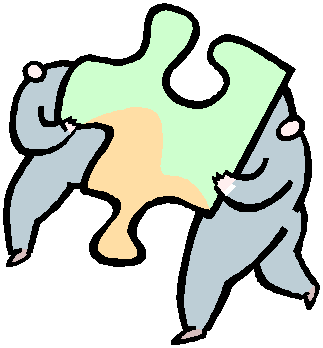
Leslie Owen Wilson/Updated Spring 2004
We learn 85-95% of what we teach others
Important Link: General overview from "official" Jigsaw Site

Directions:
Originally, the jigsaw concept was developed in the 1960's to facilitate racial
integration through collaborative instructional settings. It can be classified
as part of the "social family"of teaching and learning models.
There are several variations of the Jigsaw Model.
Here is the one we are going to use.
Procedures:
Specific subject area content, processes, or information is divided so
that instructional, collaborative groups can be formed.
The class is divided into two assigned sections -- an expert
group, and an instructional group. Different people must be in each
group.
In
the expert group students read, discuss, and develop assigned materials or
concepts into a teaching presentation for their peers.
After the preparation period, an expert from each group is assigned to an
instructional group. Here
each expert teaches his or her portion to the others in the instructional
group.
While
there are a myriad of arrangements that can be devised for the jigsaw, please,
remember that the intent is to encourage retention of at least a portion of
material being taught, and also, to encourage collaboration among participants.
Thus, you will want to assure that all participants:
1) carry their weight in the preparation of materials and expertise, and
2) are generally compatible with members, both in the expert group and in the instructional group.
You want groups divided as evenly as possible. Instructional groups usually consist of smaller numbers than expert groups. Students should have set time limits for teaching presentations in their instructional groups.
 You can evaluate lessons in different ways:
You can evaluate lessons in different ways:
Through a test on assigned materials, this can be teacher or student
constructed with the students from the expert groups devising questions for
their portion of the materials.
Also, collaborative and academic behaviors, and preparation can be peer-reviewed and evaluated. These reactions can be shared with participants in a debriefing session after the instructional portion of the jigsaw presentation. If students engage in debriefing, they need to be coached on appropriate responses and collegial behaviors. Debriefing can be conducted in expert groups discussing what worked and what didn't, and/or in instructional groups discussing presentation strengths, methods and weaknesses. Or, debriefing can take place as a whole class discussion mapping collectively what was learned.
If desired, teachers can evaluate students� teaching performances too, and
students can evaluate, reflectively, their own performances in both groups so
that ultimately evaluation is triangulated between peers, each student, and the
teacher.